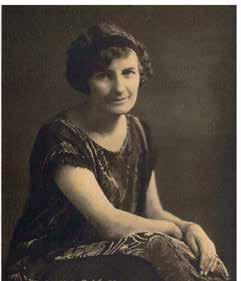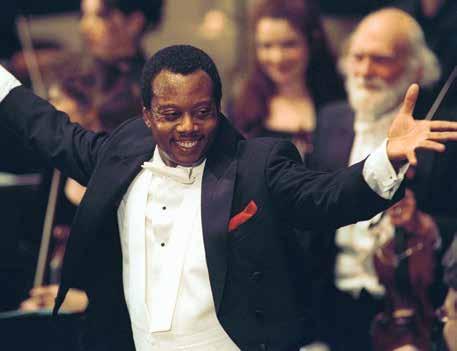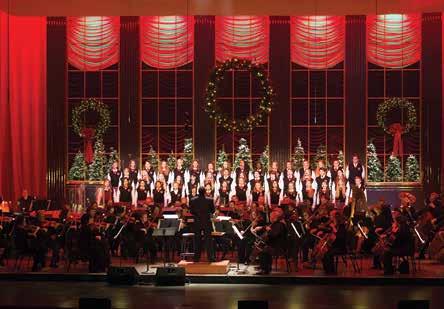
6 minute read
Five Faves — Five historical facts about the Kalamazoo
Five Faves Five essential aspects of the Kalamazoo Symphony Orchestra
by JANE ROOKS ROSS & ZAIDE PIXLEY
Advertisement
How remarkable it is to have a century of symphonic music in Kalamazoo, performed in good and tough times, buoyed by community support and committed musicians! As the authors of a book celebrating the Kalamazoo Symphony Orchestra’s 100-year history (available in fall 2021), we offer these five essential aspects of the KSO’s history and achievements:
The Beginning
The KSO began because of Leta G. Snow, a tenacious, creative woman with a vision and the ability to put it into action. She made the case, found the musicians, connected with the community, persuaded civic leaders to join her, set up rehearsals in Harry Parker’s automobile showroom downtown and named the right conductor in Chester Bronson. Her orchestra made its debut in 1921.
Snow, along with determined conductors and musicians, kept the orchestra playing through challenging times, refusing to be daunted, always finding a way to respond. During the Depression, she gave patrons IOUs to keep them coming to concerts. During World War II, when 26 players left the orchestra to join the armed forces, she went to Fort Custer and recruited more.
Her vision extended to the nation. In 1941, she founded the American Symphony Orchestra League, which is still going strong as the League of American Orchestras. She gained a reputation for the KSO that’s bigger than the size of its home. She lived to be 101. Leta Snow
Accolades and Awards
Over the years the symphony has been recognized nationally for its outsized impact: • 1937: Harvard University praises it as a “model orchestra.” • 1943: The Office of War Information chooses the KSO for a concert recording reaching tens of thousands of service members.
• 1966: The Ford Foundation awards the KSO a Community Building Grant. • 1980: The American Society of Composers, Authors and Publishers (ASCAP) awards the KSO for its Adventuresome Overall Programming of Contemporary Music. • 2004: The League of American Orchestras presents its Silver Medal to the KSO League in honor of the Instrument Petting Zoo.

• 2007: The Mellon Foundation selects the KSO for its Music Alive/Meet the Composer grant. • 2008: MetLife gives the KSO its Award for Arts Access in Underserved Communities. • 2014: The Midori Orchestra Residency Program brings the renowned violinist Midori to Kalamazoo to work with the KSO and Junior Symphony in rehearsals and concerts. • 2018-2020: Carnegie Hall’s Weill Music Institute for PlayUSA selects the KSO’s youth programs Kalamazoo Kids in Tune and Orchestra Rouh as grant recipients.
A Stellar Roster of Conductors
The KSO has a history of outstanding conductors who have stretched the orchestra and inspired its audiences, including:

• Herman Felber (1934–1959), who solidified the orchestra’s professionalism — and brought lobsters for the players to enjoy during rehearsal breaks. • Gregory Millar (1961–1968), who began the popular “Starlight
Concerts” on the Gilmore Bros. department store’s parking structure roof.
• Pierre Hétu (1968–1974), who added sophisticated French music to the mix.
• Yoshimi Takeda (1974–1999), who helped establish the KSO String Quartet, hired an education director, and enhanced the orchestra’s artistry. • Raymond Harvey (1999–2017), pictured above, who engaged audiences in “World of” concerts and pre-concert talks and brought a new level of precision and discipline to the orchestra. • Julian Kuerti (appointed in 2018), who has presented stunning performances of masterworks, promoted enticing new music, and initiated the “Craft Music” performances at Bell’s Eccentric Café.
A Collaborative Effort
Formed by musicians eager to play in an orchestra, a civicminded community ready to support them and audiences wanting to hear symphonic music, the KSO has partnered with educational, arts and other organizations to bring inspiring musical experiences to the community throughout its history. These collaborations bring a richness of resources and expertise and have even spawned new arts entities. In 1977, when an adult chorus was needed for a performance, the singers who participated had so much fun that they formed a community choir: the Kalamazoo Singers. Four years later, when an opera called for children’s voices, those involved became the Kalamazoo Children’s Chorus.
More recently, a Family Discovery Concert coupled the Westhuizen Duo pianists in Saint-Saens’ Carnival of the Animals with Djembe Yaru West Afrikan Drumming and the Rootead Youth Dance Company.

A Mission to Educate

Education has been a priority from the beginning. In the 1930s, the KSO’s Women’s Committee presented programs to build the community’s knowledge about the symphony. In the late 1940s, a concert was attended by 500 schoolchildren who had been studying the music. In the 1950s, KSO musicians formed ensembles that traveled to area schools — ensembles that are still on the move. The early 1970s marked the start of the Young People’s Concerts, attended by hundreds of schoolchildren who were bused to performances in Miller Auditorium. By the 1990s these concerts were performed for thousands of students from six counties. In 1994, the Upjohn Mason Grandchildren’s Chair in Music Education was created — a full-time music education position — making the KSO one of the few American orchestras of its size to have such resources. Jane Rooks Ross (coauthor of this piece) was chosen as its first director. Now the KSO offers more than 20 education and community programs, including Kalamazoo Kids in Tune and Orchestra Rouh for school-aged children, Marvelous Music for preschoolers and sensory-friendly programming for all ages. Education programs reach approximately 26,000 students and their teachers annually and occur in more than 100 schools. These include annual Youth Concerts for up to 13,000 students and their teachers, capping months of in-class music study. The 10 concerts over five days serve students from 38 school districts across 10 Southwest Michigan counties.
About the Authors
Jane Rooks Ross is the founding director of education for the Kalamazoo Symphony Orchestra. A lifelong educator, she has taught in area grade schools and the WMU Honors College and at Kalamazoo Valley Community College and Kalamazoo College. As a consultant, she writes grants and educational materials, including “Listener’s Guide to the Orchestra.” Ross holds a master of music degree in music education from WMU. She has been honored as a YWCA Woman of Achievement and Community Medal of Arts Award winner by the Arts Council of Greater Kalamazoo and received the PRISM award from the Sigma Alpha Iota International Music Fraternity. She was featured in Amazing Women of West Michigan and serves on the KSO Board of Directors. Zaide Pixley’s work as an educator began at P.S. 58 in the Bronx, New York, and continued at Interlochen and the University of Michigan, where she earned a Ph.D. in musicology. A member of the faculty at Kalamazoo College for 31 years, she is now professor emerita. She has offered courses on a wide range of subjects from music history and theory to rock ’n’ roll. Pixley has served as executive director of the Kalamazoo Bach Festival, was a concert reviewer for the Kalamazoo Gazette and is now program note annotator for the Gilmore Keyboard Festival. She is the author of Great Ensemble, a history of the first 75 years of the Kalamazoo Symphony Orchestra.









